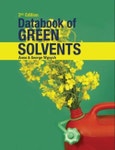The field of green solvents changes rapidly and continuously. It can be well evidenced from the turnover of solvents in this book. Forty-five solvents included in the previous edition are not produced or considered green anymore and they are replaced in the book by about 70 new solvents considered as green replacements of the presently used products.
The list of solvents used in the industry rapidly changes because replacement “greener” solvents are becoming available and because of an anticipation that some solvent(s) will be banned by authorities soon. Because this book is designed to assist industry in the selection of suitable solvents it has to be frequently updated by the current trends and findings. It not only provides data on carefully selected, commercially available, green solvents but it also gives concise advice on how to assess and qualify green solvents.
The Databook of Green Solvents contains data divided into five sections: General, Physical, Health, Environmental, and Use.
In the General section, the following data are displayed: Name, CAS number, Acronym, Chemical category, Empirical formula, IUPAC name, Mixture, Moisture contents, Molecular weight, Other properties, Product contents, EC number, RTECS number, and Synonyms 1, 2, 3.
Physical section contains data on Dielectric constant, Acceptor number, Acid dissociation constant, Aniline point, Antoine temperature range, Antoine constants A, B, and C, Boiling temperature, Coefficient of thermal expansion, Color, Corrosivity, Donor number, Electrical conductivity, Evaporation rates with butyl acetate=1 and ether=1, Freezing temperature, Hansen solubility parameters dD, dP, and dH, Molar volume, Heat of combustion, Enthalpy of vaporization, Enthalpy of vaporization temperature, Henry's law constant, Hildebrand solubility parameter, Kauri butanol number, Odor, Odor threshold, pH, Polarity parameter, ET(30), Refractive index, Solubility in water, Specific gravity, Specific gravity temperature, Specific heat, State, Surface tension, Thermal conductivity, Vapor density, Vapor pressure, Vapor pressure temperature, Viscosity, and Viscosity temperature.
Health section contains data on Autoignition temperature, Carcinogenicity: IRAC, NTP, OSHA, Mutagenic properties, Reproduction/developmental toxicity, DOT class, TDG class, ICAO/IATA class, packaging group, IMDG class, packaging group, UN/NA hazard class, UN packaging group, Proper shipping name, Explosion limits: lower and upper, Flash point, Flash point method, LD50 dermal (rabbit), LC50 inhalation (rat), LD50 oral (mouse), LD50 oral (rat), Maximum concentration during 30 min exposure (NIOSH-IDLH), Maximum concentration at any time: ACGIH, NIOSH, OSHA, Maximum concentration during continuous exposure for 15 min: ACGIH, NIOSH, OSHA, NFPA flammability, health, reactivity, HMIS flammability, health, reactivity, Route of entry, Ingestion, Skin irritation, Eye irritation, Inhalation, First aid: eyes, skin, inhalation, Chronic effects, Target organs, Threshold limiting value: ACGIH, NIOSH, OSHA, UN number, UN risk phrases, and UN safety phrases.
Environmental section contains data on Aquatic toxicity, Bluegill sunfish (96-h LC50), Daphnia magna (96-h LC50) and (48-h LC50), Fathead minnow (96-h LC50), Rainbow trout (96-h LC50), Bioconcentration factor, Biodegradation probability, Biological oxygen demand (20-day test) and (5-day test), Chemical oxygen demand, Atmospheric half-life, Hydroxyl rate constant, Global warming potential, Montreal protocol, Partition coefficient, Ozone depletion potential (CFC11=1), Ozone rate constant, Soil absorption constant, Theoretical oxygen demand, Urban ozone formation potential (C2H4=1), UV absorption.
Use section contains information on Manufacturer, Outstanding properties, Potential substitutes, Recommended for polymers, Features & benefits, Processing methods, Recommended dosage, and Recommended for products.
The table of contents gives more information on solvent groups included in the Databook of Green Solvents. Solvents are divided into 14 essential groups of green products. Emphasis is given to safer and more efficient replacements of more toxic solvents. In addition to this publication, Databook of Solvents contains data on the solvents which are the most frequently used today in the manufacturing processes. Majority of these solvents belong to a group of the high production volume solvents which are produced or imported at levels greater than 1,000 tones per year by at least one member country.
Readers interested in this subject should note that two volumes of fundamental treatment of all essential areas of solvents’ use have also been just published. They include Handbook of Solvents. Volume 1. Properties and Handbook of Solvents. Volume 2. Use, Health, and Environment. Together these four books provide the most comprehensive information on the subject of solvents ever published. The books are the authoritative sources of knowledge, considering that very well-known experts in the fields of solvent use were involved in the creation of these extensive publications. An essential aim of these books is to keep their information updated by findings from the most recent literature and developments occurring in the field of solvents.
Table of Contents
1 What does make solvent green?
2 Information on the data fields
3 Solvents
3.1 Biodegradable solvents
3.2 Biorenewable solvents
3.3 Deep eutectic solvents
3.4 Esters
3.5 Fatty acid methyl esters
3.6 Generally recognized as safe, GRAS, solvents
3.7 Generic solvents
3.8 Hydrofluoroethers
3.9 Ionic liquids
3.10 Perfluorocarbons
3.11 Siloxanes
3.12 Sulfoxides
3.13 Supercritical fluids
3.14 Terpenes








